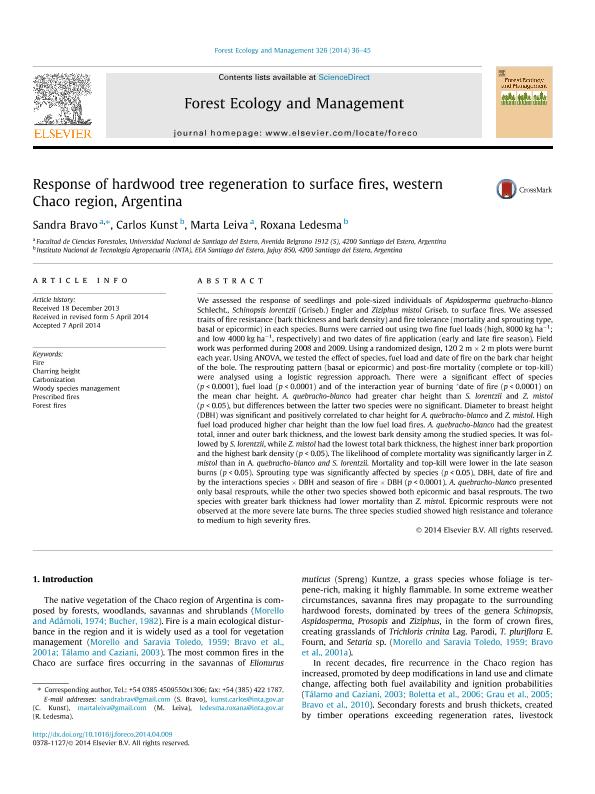Mostrar el registro sencillo del ítem
dc.contributor.author
Bravo, Sandra

dc.contributor.author
Kunst, Carlos Roberto Guillermo

dc.contributor.author
Leiva, Marta Elisabeth

dc.contributor.author
Ledesma, Roxana
dc.date.available
2018-01-17T18:46:29Z
dc.date.issued
2014-05
dc.identifier.citation
Bravo, Sandra; Ledesma, Roxana; Leiva, Marta Elisabeth; Kunst, Carlos Roberto Guillermo; Response of hardwood tree regeneration to surface fires, western Chaco region, Argentina; Elsevier; Forest Ecology and Management; 326; 0; 5-2014; 36-45
dc.identifier.issn
0378-1127
dc.identifier.uri
http://hdl.handle.net/11336/33660
dc.description.abstract
We assessed the response of seedlings and pole-sized individuals of Aspidosperma quebracho-blanco Schlecht., Schinopsis lorentzii (Griseb.) Engler and Ziziphus mistol Griseb. to surface fires. We assessed traits of fire resistance (bark thickness and bark density) and fire tolerance (mortality and sprouting type, basal or epicormic) in each species. Burns were carried out using two fine fuel loads (high, 8000 kg ha−1; and low 4000 kg ha−1, respectively) and two dates of fire application (early and late fire season). Field work was performed during 2008 and 2009. Using a randomized design, 120 2 m × 2 m plots were burnt each year. Using ANOVA, we tested the effect of species, fuel load and date of fire on the bark char height of the bole. The resprouting pattern (basal or epicormic) and post-fire mortality (complete or top-kill) were analysed using a logistic regression approach. There were a significant effect of species (p < 0.0001), fuel load (p < 0.0001) and of the interaction year of burning *date of fire (p < 0.0001) on the mean char height. A. quebracho-blanco had greater char height than S. lorentzii and Z. mistol (p < 0.05), but differences between the latter two species were no significant. Diameter to breast height (DBH) was significant and positively correlated to char height for A. quebracho-blanco and Z. mistol. High fuel load produced higher char height than the low fuel load fires. A. quebracho-blanco had the greatest total, inner and outer bark thickness, and the lowest bark density among the studied species. It was followed by S. lorentzii, while Z. mistol had the lowest total bark thickness, the highest inner bark proportion and the highest bark density (p < 0.05). The likelihood of complete mortality was significantly larger in Z. mistol than in A. quebracho-blanco and S. lorentzii. Mortality and top-kill were lower in the late season burns (p < 0.05). Sprouting type was significantly affected by species (p < 0.05), DBH, date of fire and by the interactions species × DBH and season of fire × DBH (p < 0.0001). A. quebracho-blanco presented only basal resprouts, while the other two species showed both epicormic and basal resprouts. The two species with greater bark thickness had lower mortality than Z. mistol. Epicormic resprouts were not observed at the more severe late burns. The three species studied showed high resistance and tolerance to medium to high severity fires.
dc.format
application/pdf
dc.language.iso
eng
dc.publisher
Elsevier

dc.rights
info:eu-repo/semantics/openAccess
dc.rights.uri
https://creativecommons.org/licenses/by-nc-sa/2.5/ar/
dc.subject
Fire
dc.subject
Charring Height
dc.subject
Carbonization
dc.subject
Woody Species Management
dc.subject
Prescribed Fires
dc.subject
Forest Fires
dc.subject.classification
Otras Ciencias Biológicas

dc.subject.classification
Ciencias Biológicas

dc.subject.classification
CIENCIAS NATURALES Y EXACTAS

dc.title
Response of hardwood tree regeneration to surface fires, western Chaco region, Argentina
dc.type
info:eu-repo/semantics/article
dc.type
info:ar-repo/semantics/artículo
dc.type
info:eu-repo/semantics/publishedVersion
dc.date.updated
2018-01-16T18:05:17Z
dc.journal.volume
326
dc.journal.number
0
dc.journal.pagination
36-45
dc.journal.pais
Países Bajos

dc.journal.ciudad
Ámsterdam
dc.description.fil
Fil: Bravo, Sandra. Universidad Nacional de Santiago del Estero. Facultad de Ciencias Forestales; Argentina
dc.description.fil
Fil: Kunst, Carlos Roberto Guillermo. Instituto Nacional de Tecnología Agropecuaria; Argentina
dc.description.fil
Fil: Leiva, Marta Elisabeth. Universidad Nacional de Santiago del Estero. Facultad de Ciencias Forestales; Argentina. Consejo Nacional de Investigaciones Científicas y Técnicas; Argentina
dc.description.fil
Fil: Ledesma, Roxana. Instituto Nacional de Tecnología Agropecuaria; Argentina
dc.journal.title
Forest Ecology and Management

dc.relation.alternativeid
info:eu-repo/semantics/altIdentifier/url/https://www.sciencedirect.com/science/article/pii/S0378112714002345
dc.relation.alternativeid
info:eu-repo/semantics/altIdentifier/doi/http://dx.doi.org/10.1016/j.foreco.2014.04.009
Archivos asociados
